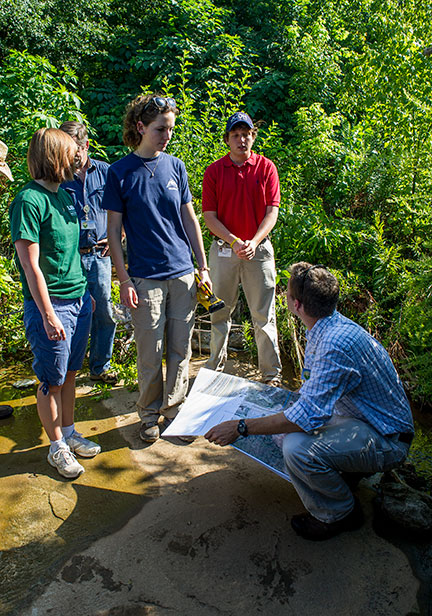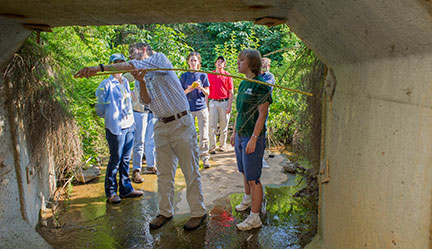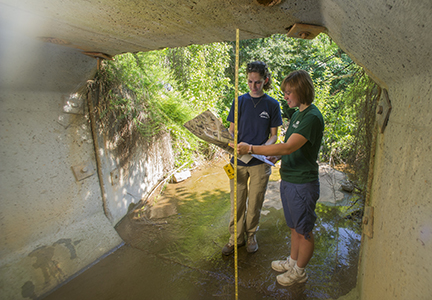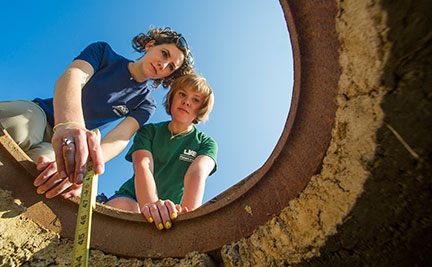 Sophomores Chapelle Ayres and Ali Fry arrived at UAB two years ago with the same dreams and goals of most students. They needed experience in their fields of study — biology for Ayres and math for Fry — but they figured it would be a while before they got their hands dirty.
Sophomores Chapelle Ayres and Ali Fry arrived at UAB two years ago with the same dreams and goals of most students. They needed experience in their fields of study — biology for Ayres and math for Fry — but they figured it would be a while before they got their hands dirty.
Boy, were they wrong.
This summer, Ayres and Fry got a first-hand look at evidence-based problem-solving as part of a team using GPS to locate and mark storm drains in the Brighton community. They carried flashlights, rulers and maps and waded through tall grass, brush and water and worked with Jefferson County Department of Health employees and UAB faculty to log locations and other information.
The two are participants in UAB’s new Global Health Service Learning program, which combines community service with classroom instruction to promote critical, reflective thinking and personal and civic responsibility. Global health work continues to increase in popularity, and this area of special interest is transforming into a valuable academic discipline at the crossroads of public health, globalization, politics and human rights.
“This has been an amazing opportunity for Ally and me,” Ayres said. “I have had a lot of fun and learned something new every day. It’s been a little bit like a treasure hunt.”
A good start
An interdisciplinary team of UAB faculty led by Nalini Sathiakumar, M.D., Dr.P.H., professor of epidemiology in the School of Public Health, introduced the program this past spring. Mary Evans, deputy director of UAB’s Center for the Study of Community Health, contacted area agencies to gauge their interest in partnering with UAB, and the county’s Watershed Protection Division jumped at the chance to develop a model for mapping the storm drains in its cities.
 Phase I began two years ago, says Scott Hofer, environmental biologist at the health department. The GPS coordinates of county storm drains were marked, and the conditions and type of each drain — a gutter, curb or grate — was noted.
Phase I began two years ago, says Scott Hofer, environmental biologist at the health department. The GPS coordinates of county storm drains were marked, and the conditions and type of each drain — a gutter, curb or grate — was noted.
The JCDH created a map of the drain locations — marked by dots — but not their pathways. Ayres, Fry and other researchers had the task of finding and connecting the dots.
“Joining the dots is Phase II,” Hofer said. “Essentially, with GPS, we’re defining the whole world in points, lines and polygons. This takes a lot of time and groundwork, but it needs to be done. The help these students and UAB is providing is invaluable.”
A better way
This work is important for several reasons. Many of these drainage systems are more than 50 years old, and many municipalities in Jefferson County don’t know the infrastructure they have. The maps will enable them to better assess their needs.
“They will be able to see that a drain is a 24-inch concrete pipe, for example,” Hofer says. “And we can tell them they have 1.3 miles of concrete pipe and one mile of corrugated metal and show them exactly where they are located. Then, if they need to upgrade, they will know what they have.”
 And upgrades are needed. Brighton, for example, has had flooding along Bessemer Superhighway for many years. The health department believes one cause is backups in the drainage system, perhaps due to deteriorating storm drains.
And upgrades are needed. Brighton, for example, has had flooding along Bessemer Superhighway for many years. The health department believes one cause is backups in the drainage system, perhaps due to deteriorating storm drains.
Now, if a chemical truck overturns, any contaminant that makes it into the drainage system could wind up in area creeks, Hofer said.
“We don’t have any idea where it will enter,” Hofer said. “Mapping the system gives us an idea of the options to stop a contaminant from getting into the storm drain and, ultimately, our creeks.
Conversely, if a high reading of conductivity is found in a creek, a map of the storm drain system will narrow the drainage areas to inspect, he said.
Fry says many residents have come out onto their porches and neighborhood streets to ask what they are doing. She says it gives her a sense of pride to let the residents know they are there to help.
“They usually thank us because they say their storm drains often are filled and clogged and their houses flood,” Fry said. “It’s been great to come out here, map these drains and meet people. I’m learning something and making a difference at the same time.”

Rewarding work
That’s the point of the program — teach students to apply social, corporate and other models to devise tangible solutions to a community problem. The projects help them understand their own professional identity and gain an understanding of other professional roles on the team, Sathiakumar said. “Students also learn that giving to others will shape their success.”
UAB Service Learning Coordinator Libba Vaughan says this lesson is vital. “Students experience the connection between classroom and real-life and the rewards that come from collaborating with community partners. It enables them to see the value of their own academic learning and civic engagement.”
Other projects this fall will pair students with Cahaba Valley Health Care, One Roof, Christ Health Center and Urban Ministry. In 2014, the program will expand to include international partners and projects.
For more information on the program contact Tamika Ryan, Mary Evans or Libba Vaughan.
